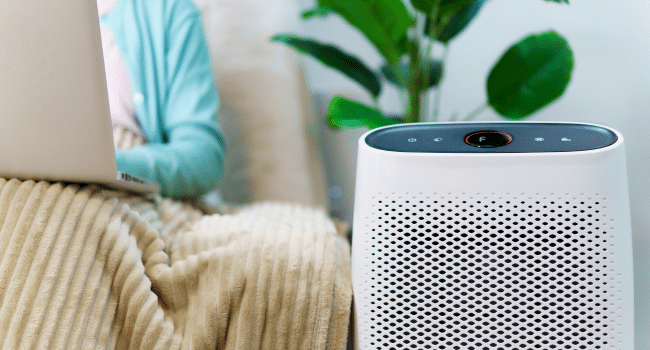Table of Contents
Have you ever thought your air feels stuffy? Or do your allergies or asthma act up more than normal in your own home? Maybe it’s time to get an air purifier. Air purifiers can lessen triggers that cause asthma and allergy attacks. Here’s a short guide to make sure you get the right one to better your health and your family’s health.
Types of Air Pollutants
Indoor air quality (IAQ) is more important than people realize. Do you know what’s in the air that can cause you health problems? Not only can it affect your allergies but it can cause serious long-term effects like respiratory problems and even cancer in extreme cases. Here is a list of the most common air pollutants in your home.
- Asbestos
- Carbon Monoxide (CO)
- Radon
- Pet Dander
- Dust
- Pollen
- Bacteria
- Viruses
- Volatile Organic Compounds (VOCs)
How Air Purifiers Work
Now we know what’s in the air let’s go over how air purifiers work to your benefit.
Air purifiers have filters inside them that sucks air in and circulates the air trapping the air pollutants in the filter. After the dirty air is filtered the clean air gets pushed out so you can breathe in cleaner air. You will need to replace these filters when they get dirty or you the filter will no longer work and you will be back to breathing air pollutants. You will typically replace these filters every year or if you have it running constantly you might need to change it more often.
Choosing the Right Air Purifier
Choosing the right air purifier for your home depends on a few factors.
- Room Size
- Customer Ratings
- Clean Air Delivery Rate (CADR)
Location
No matter the size of your home there are many places you can put an air purifier to get the best IAQ. The most popular location in your home is your living room, a very high-traffic area. Other areas where it can benefit you are your bedroom, kitchen, home office, children’s room, an area where your pets are most often, and rooms with high humidity like a bathroom or basement. So many spaces in a home, depending on the size of your air purifier it can go on the ground in the corner of the room, or on a table in the center of a room. The choice is yours depending on your needs.
Benefits of Using Air Purifiers
Not only does an air purifier help with allergies and asthma but it benefits you in so many other ways! It helps get rid of VOCs in the air that are caused by cleaning supplies, pesticides, and even some building materials. They also help get rid of unwanted odors and musty smells, using a carbon filter. If you put an air purifier in your bedroom it can help you get better sleep as well.
Maintenance and Care
Many air purifiers have more than one air filter so you need to make sure you replace them all at the same time with a filter that is approved by the manufacturer. It’s also important to wipe down the air purifier on the outside with a dry or lightly damp microfiber cleaning cloth.
Create a Healthier Home
Air purifiers can make a real difference in your home’s air quality and your family’s health. By understanding what pollutants they tackle and how they work, you can choose the right one for your needs. Beyond easing allergies and asthma, they banish odors, promote better sleep, and even tackle harmful chemicals. Just remember to keep up with maintenance for the best performance. With an air purifier, you’re investing in fresher, cleaner air and a healthier home for everyone.
Read More on KulFiy
Can a Higher Air Purifier Price Guarantee Better Quality
The Crucial Role Of Industrial Pedestal Fans In Tackling Indoor Air Pollution
The Importance of Regular Air Duct Cleaning: Enhancing Indoor Air Quality
